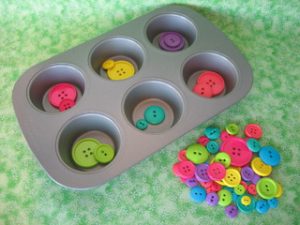 “One-to-one correspondence” may seem like a mouthful when thinking in terms of pre-school and kindergarten math, but the concept is the foundation for all mathematics and is fundamental to counting. And not only that, it can be a lot of fun!
“One-to-one correspondence” may seem like a mouthful when thinking in terms of pre-school and kindergarten math, but the concept is the foundation for all mathematics and is fundamental to counting. And not only that, it can be a lot of fun!
How Children Learn Numbers and Counting
Young children learn their numbers by hearing them being counted out in song or as their parents and teachers teach them their one, two, threes. As they learn the number words they often repeat them in random order, “one, three, nine, two, six”. They may count and point to objects – oftentimes saying more numbers than there are objects or pointing to more objects than they say numbers. This is a good thing! Hearing the numbers, repeating the numbers, and beginning to have an understanding that they represent objects are the first steps in learning to count.
What is One-to-One Correspondence?
One of the next steps is learning one-to-one correspondence. One-to-one correspondence is often thought of as simply matching, and to a great degree this is true. However, counting in the correct number sequence is equally important. The Common Core State Standards (CCSS) for kindergarten math describe one-to-one correspondence in this way:
When counting objects, say the number names in the standard order, pairing each object with one and only one number name and each number name with one and only one object. K.CC 4a
The Imperfect Role of Rote Memorization
As children practice saying the numbers through repetition they may eventually learn the number sequence by rote memorization. In other words, they may be able to say the number words in the correct order but will not have an understanding of what each number means. This is where one-to-one correspondence comes in.
Children learn to count as they simultaneously point to, touch or move objects one at a time. This process takes some time as there is a degree of coordination involved in moving the hand one time for each object. As children perfect this process they will come to have a clear understanding of the number sequence and the quantity that each number represents.
Practicing One-to-One Correspondence
One-to-one correspondence can be practiced easily at home. For practice holding a pencil, one-to-one correspondence worksheets can be very beneficial. Children especially love one-to-one correspondence activities. Nothing beats hands-on matching and counting activities where children can move objects, pull or turn cards, play games, and make noise! Here are some examples of how children can practice one-to-one correspondence at home and at school:
Matching:
- Match one object to another identical object. For example, a worksheet may have pictures of identical objects on both sides of the page. Children draw a line to the matching objects.
- Match one number to the same number. Use dominoes in a simple way by matching the numbers on two playing pieces.
- Match one set to another set. For example, match a picture of five turtles with another picture of five turtles.
- Match objects that go together. A pair of shoes and a pair of socks would be put together as a match as well as a letter and a mailbox.
- Match a number to a group of equal objects. In other words, match the number 3 with three toy cars.
- Match using memory matching games. Children love matching pictures of numbers, animals, or their favorite TV characters.
Counting:
- Use an abacus. Count one number in the count sequence for each bead that is moved.
- Roll a dice. For the number that is rolled put that many objects in a cup, tub, ice cube tray, muffin tin, egg carton, etc.
- Use what you’ve got. Count fingers and toes!
- Pull a number card. Pull a number card then count out the number in snacks like Goldfish, Teddy Grahams, or Cheerios. (The reward for all that counting: eating the snack!)
- Make some noise. Count each time you clap your hands or beat a drum.
- Keep in step. Count each time a step is taken.
- Blow some bubbles. Count in the counting sequence each time a bubble is popped.
- Counting games. Duck, Duck Goose (also called The Fox and the Hunter) is a wonderful game for one-to-one-correspondence.
Happy counting…in the correct number sequence of course!
–Sheri


